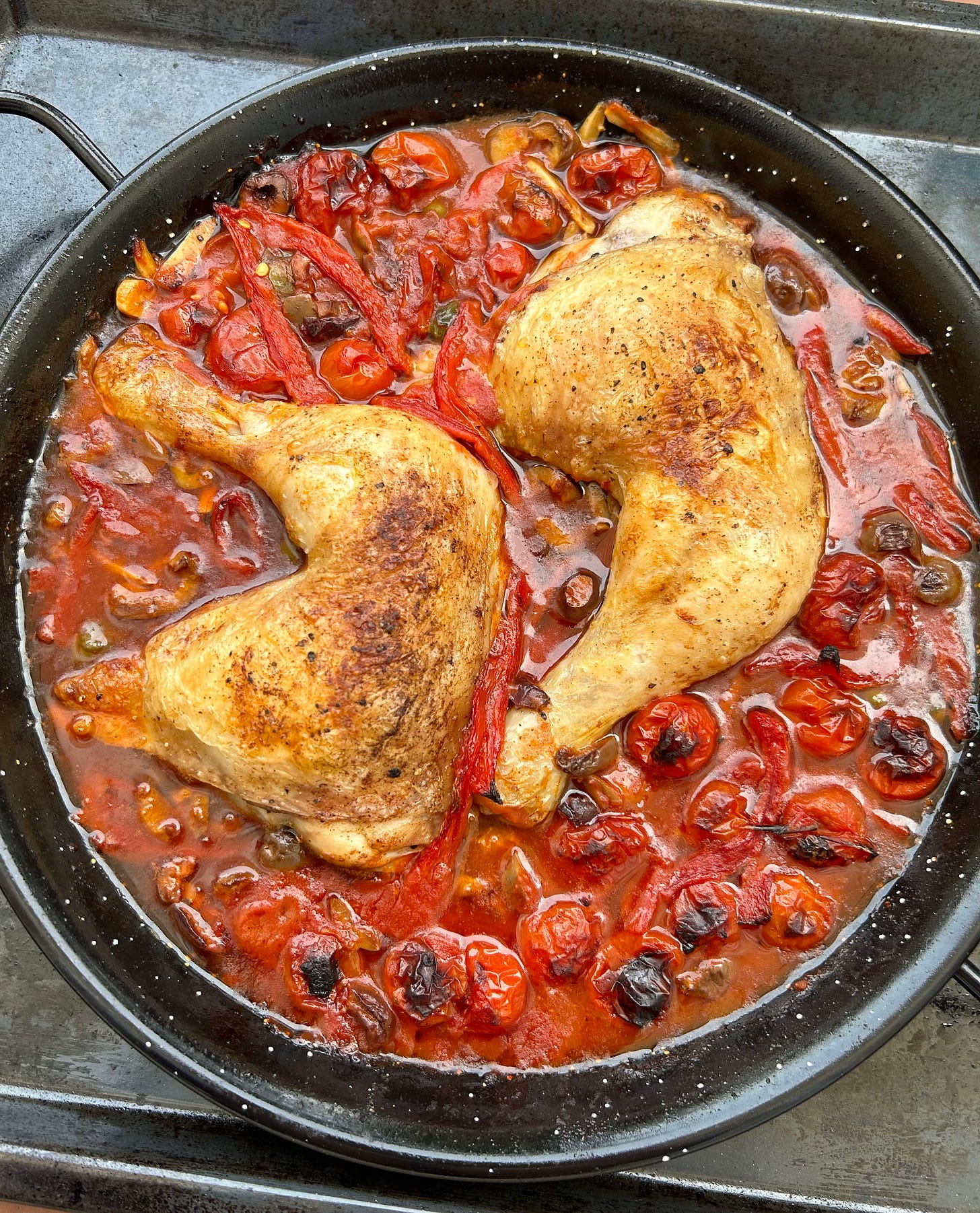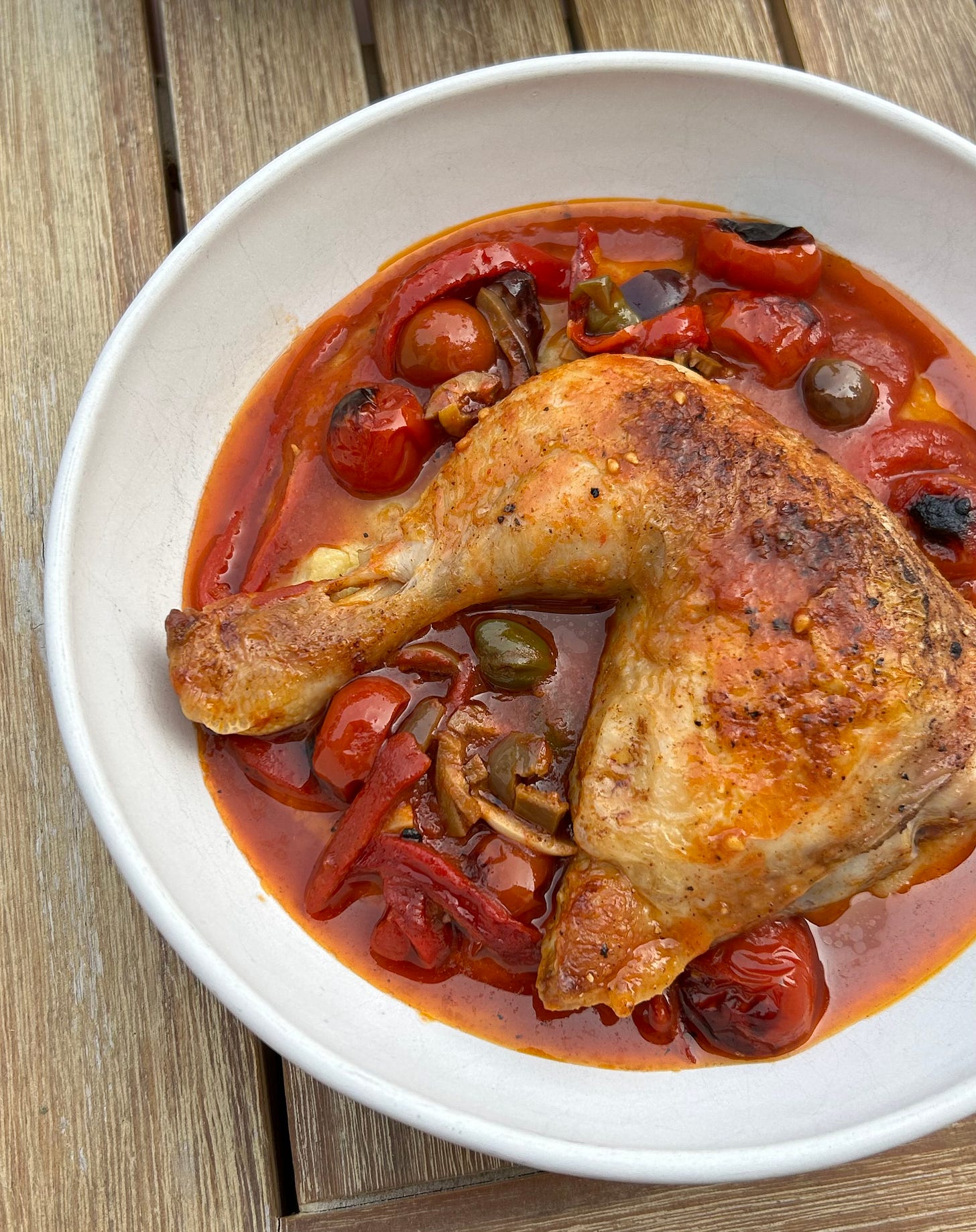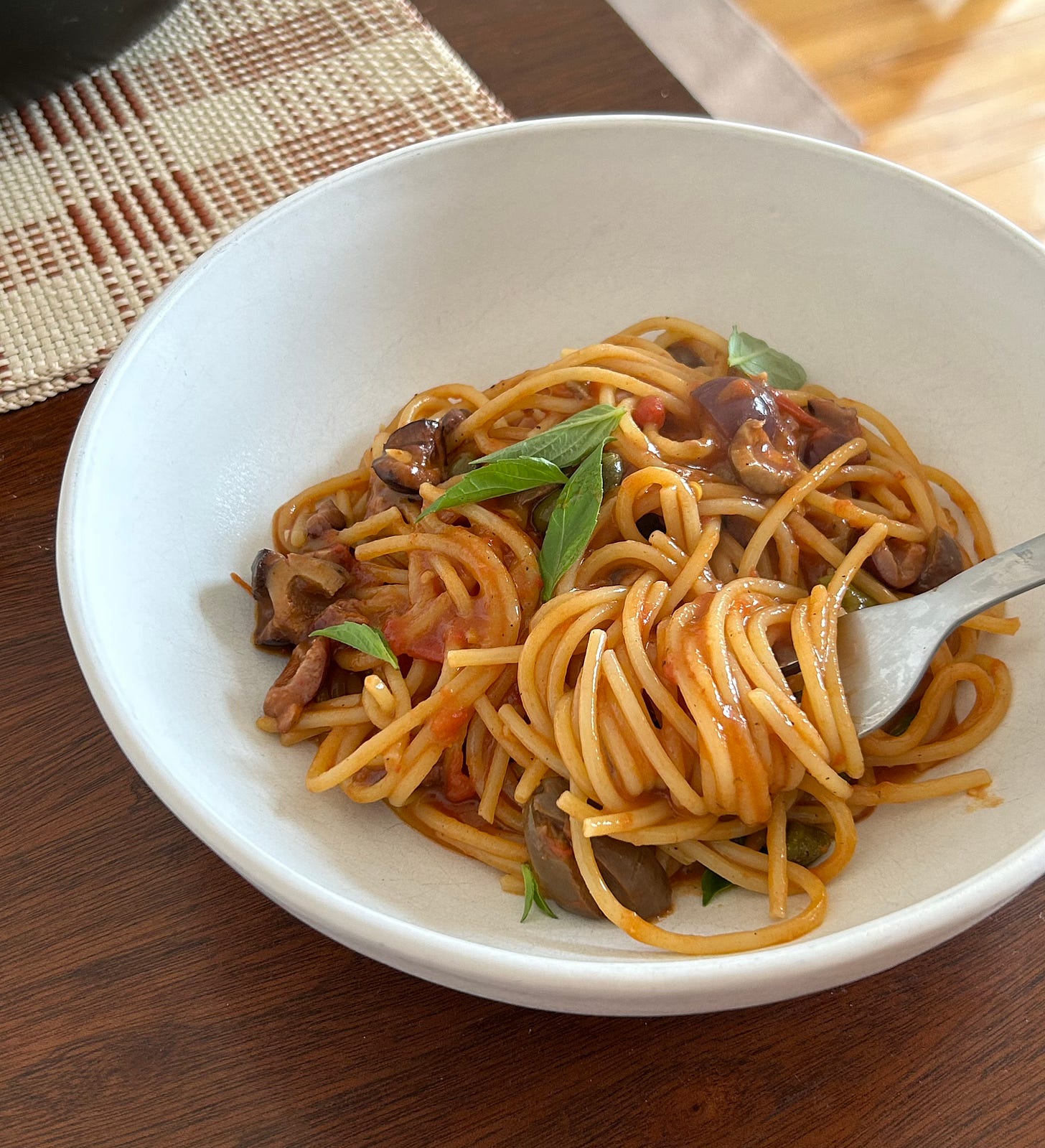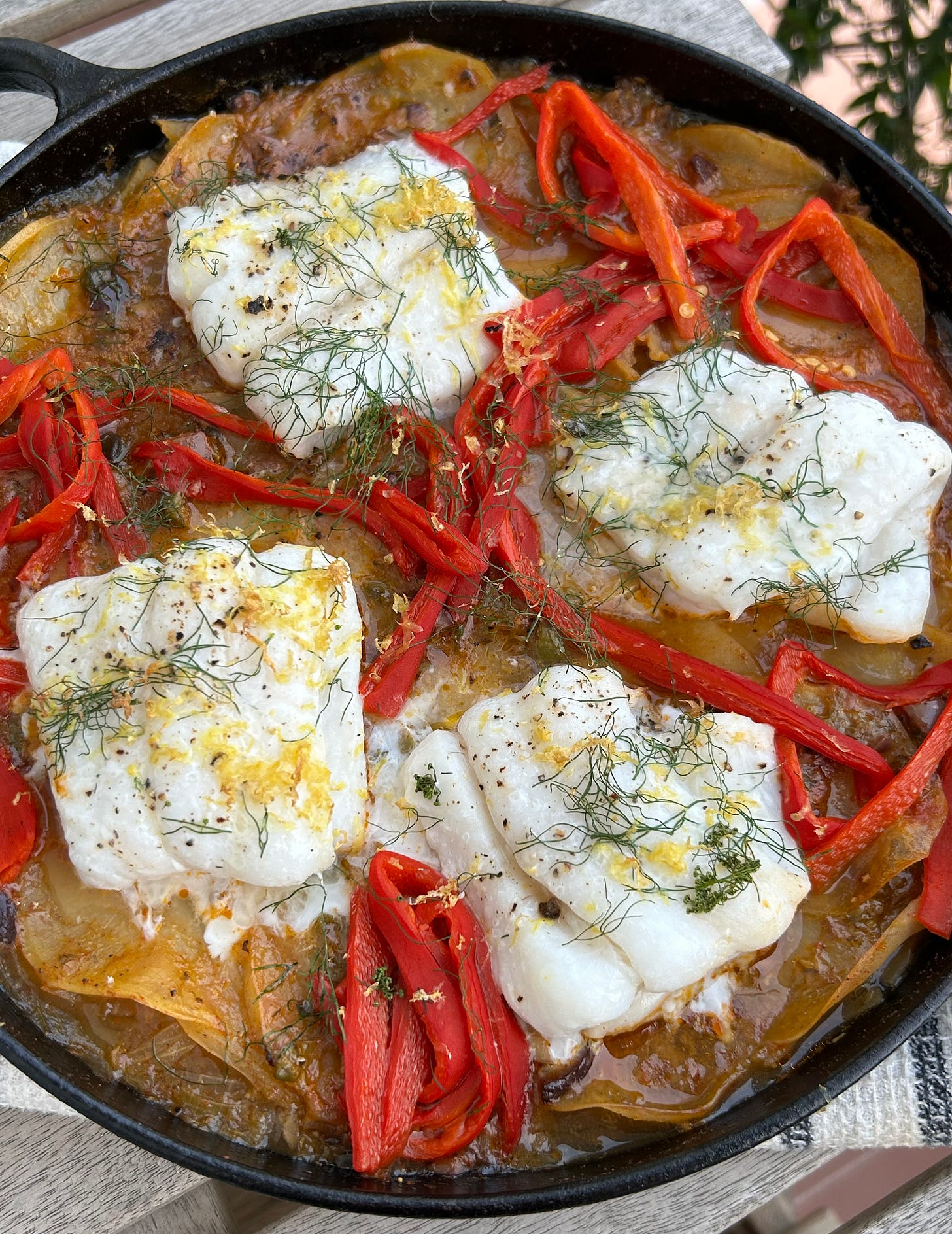What to Cook Tonight #10
Hearty flavours from southern Europe — a Spanish Baked Chicken with Creamy Polenta, Pantry Puttanesca for all your pasta cravings, and a simple and oh so delicious Sicilian Roasted Fish with Potatoes.
Hello hello,
Some quick housekeeping before we begin — the recipes can be found in your downloadable pdf at the bottom of this email, as well as in plain text version at the very end (for paid subscribers only).
We are also sending out a preview to our free subscribers this week — hello, and welcome to our new subscribers! This preview is to give you all an idea of what is going on at What to Cook Tonight, and not to make anyone feel excluded. We are so grateful for your support, paid or otherwise. ❤️
This week we are introducing one of our most-used spices to the pantry: smoked paprika. Smoked paprika has a rich, earthy flavour that adds a lovely depth and smokiness to your food that is particularly satisfying in the winter months. Originating from La Vera in the west of Spain, smoked paprika is made from red peppers that are dried, smoked over an oak fire, and then ground into a fine powder.
Smoked paprika is also welcome in cuisines that share a similar climate — Portuguese, southern Italian, Greek, and even Turkish and Middle Eastern recipes. Often when we are trying to figure out if an ingredient will work with something else, we think about the climate and landscape in which it grows. Does it make sense for these things to be cooked together? Do they grow in similar environments? Is it likely that they have been combined before? Of course, sometimes there are unexpected combinations that work such as kimchi and cheese, or pineapple on pizza (debatable), but a geographical gut check is usually a good place to start.
Smoked paprika is especially good with chicken, fish, pork, potatoes, rice, eggs, tomatoes, zucchini, and eggplant. If you just can’t get enough of smoked paprika, we recommend making this Tray Bake Paella, our Shakshuka Eggs, and this fab simple Spanish Tortilla.
The other key ingredients we will be using this week are capers, olives, and jarred roasted red peppers. These are things we love to keep in the pantry, especially in the winter months when you want to open a jar of deliciousness to transport you to the sunshine. When buying olives, try to buy those that still have their pits in, as they have more flavour and are less likely to be dry and mealy. Don’t throw away your olive and caper brine! Packed with delicious salty flavour, we like to add brine to salad dressings and sauces, as we’ve done for our Niçoise Salad and this Potato Salad.
Jarred roasted red peppers are so useful to have at hand. We often thinly slice them and then marinate them with some red wine vinegar, finely chopped anchovies, grated garlic, and olive oil. This we then pile into a baguette with fresh mozzarella or burrata, fresh rocket, salt, and pepper. So good. Roasted peppers are also excellent in this Anchovy Crostini, or with Annabel’s famous Crispy Pork Belly served alongside a Roasted Pepper Pesto.
Now that we’ve established the pantry, our first recipe for this week is for a Spanish Baked Chicken with Creamy Polenta. Deeply satisfying, and so delicious, this is something we love to eat any time of year. You get so much flavour for a relatively small amount of effort which is always a win.
We’ve used chicken leg quarters for this, also known as a Maryland cut, however if you wanted you could use bone-in chicken thighs (with the skin on).
Polenta is such a great conduit for flavour as it soaks everything up so well and has such a great texture and satisfying mouth feel. If you preferred, mashed potatoes or couscous would work well here too. You just want something starchy and carby to pair with the chicken and its juices.
We’ve chosen to cook this in an ovenproof pan, but if you don’t have one, you can cook everything off in a pan and then transfer it to a roasting dish before you pop it in the oven. If you wanted to serve this with greens, we suggest some sautéed spinach, silverbeet, or broccolini/broccoli with a little lemon zest.
This recipe is easily halved — use a full can of tomatoes and ½ cup wine. There is so much flavour in the rich sauce you will savour it all! If you wanted to adapt this to be veggie you could use cauliflower — cut cauliflower crossways into big slices and sub in for the chicken (bake until golden and tender).
Leftover polenta is excellent for breakfast — we like to fry it in little patties with a bit of olive oil and serve with poached eggs and sautéed leafy greens.
Next up, we’re sharing a recipe for a One-Pot Pantry Puttanesca. The name of this famous dish literally translates as ‘whores’ pasta’. Back in the 1950s, brothels in Italy were state-owned and the ‘civil servants’ who worked there had only one day off a week for shopping. With time in short supply, this dish, made easily from pantry staples, became their specialty.
We love a one pot meal, especially during the week, allowing for minimal dishes and a speedy clean up.
As you may have gathered by now, we often use pasta water (aka liquid gold) in our pasta recipes. The reason for this is because pasta water is filled with creamy, starchy goodness, that when combined with fat, emulsifies into a luscious sauce that clings to the pasta.
For this recipe we cook the pasta in the sauce — so not only does all the amazing flavour in the sauce soak into the pasta, but all the starch goes into the dish. The result? An incredible flavour and beautiful silky texture, without the addition of any cream or cheese. So good.
This is a big recipe, which you can easily halve — use the full can of chopped tomatoes and 3 cups of stock (you want to make sure the pasta is fully submerged in liquid, or it won’t cook). If you want to make this veggie, use veggie stock and skip the anchovies. Leftover tomato paste can be frozen if you’re not going to use it within a week.
A couple of handfuls of baby spinach would be welcomed here if you wanted to sneak some greens in, as would a can of drained and rinsed chickpeas or butter beans for extra protein — add these in when you add in the stock/tomatoes. This is also excellent with roasted eggplant when it is in season.
You could finish this with fresh mozzarella or burrata if you wanted it to be cheesy, but we don’t think it needs it.
Our final recipe for this week is for Sicilian Roasted Fish with Potatoes & Onions. This is something Annabel makes all the time, particularly on a cold wintry evening. You’re going to cook down onions until they are melt in your mouth tender and almost caramelised.
Few ingredients undergo quite as radical a transformation as the humble onion. From something sharp, acrid, and literally tear-jerking it changes — with nothing more than heat, into something sweet, mellow, and comforting.
If you’re not mad on the taste of raw onions (we are not fans) but you want them for a recipe like a fresh salsa, you can take out some of their bite by soaking them in cold water for half an hour. Drain before using. Soaking sliced onions in vinegar, or even citrus juice will soften their pungency and round out their flavours, but also softens their texture. Salting sliced onions does the same thing (you will want to rinse and drain salted onion before using). When sautéing onions, it pays to add a little salt in at the start as this will start to break down and soften them more quickly as well as help reduce their volatile flavours.
Cooking onions brings out their sweetness. The longer you cook them, the sweeter they become. Sweated onions, which have a clean strong onion flavour, are cooked gently in a little bit of oil or fat, just until they begin to soften and release some liquid but don’t take on any colour. Sautéed onions are cooked for a little longer, they have a light golden colour and have a slightly sweeter flavour than sweated onions. These are the onions you want for your sausage or burger or to start a tomato-based sauce. If you keep cooking onions beyond the sautéed stage, you’ll end up with caramelised onions. These are buttery, soft and very sweet, with a rich brown colour, just what you want for a French Onion Soup or a tart such as our Classic Pissaladière.
Once you have cooked your onions down (we’re going for a sauté for this recipe) we are going add potatoes and a little water, along with our beautiful Mediterranean flavours of smoked paprika, capers, and olives. Once potatoes are tender and just cooked, the whole thing goes in the oven to quickly bake with fillets of fresh fish. Quite possibly the perfect dinner. We love this with a big fresh green salad, like our Everyday Green Salad.
If you didn’t want to use fish, the potato-onion mixture is excellent as-is with fried eggs on top and some sautéed leafy greens such as kale, cavolo nero, or silverbeet.
Keep reading with a 7-day free trial
Subscribe to The Langbein Newsletter to keep reading this post and get 7 days of free access to the full post archives.







